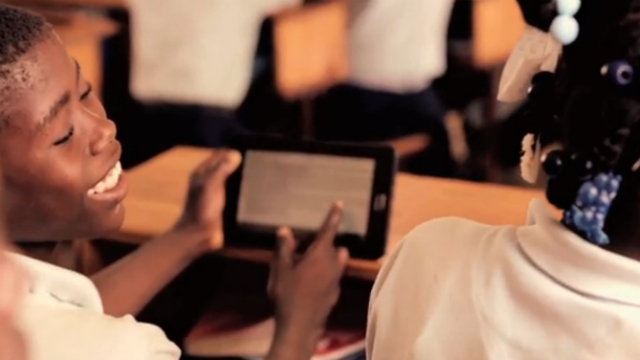The site will provide lessons, diagrams, and other resources in a less graphic, simplified form that won't cut into a school's bandwidth or data bill—which is important since pay-as-you-go data models are still common in many developing nations. With help from partner ThoughtWorks* the platform will be developed on tablets kept, in part because of the belief is that students can intuitively figure out how to use tablets, Evans said.
The pilot will be tested in a 500-student K-9 school in Respire, Haiti. Currently, Library for All is nearing a $100,000 threshold for a Kickstarter campaign aimed at funding elements of the program. More than half of that money will go toward creating the library itself, with help from volunteer partners Amplify, while the rest will be funneled to labor and travel expenses associated with launching the pilot, Evans said.
If all goes well, the hope is NGOs who are already involved in device-for-student programs around the globe will see Library for All as an intermediary that ensures quality content delivery. Sustainability, then, would mean Library for All would provide those NGOs its service for a fee, rather than running the distribution to schools around the globe itself.
“We're never going to distribute tablets to kids in developing countries,” Evans said. “We're about empowering those who already know the community needs and already have a lab or tablets and don't know what to do with them.”
Here's more about what Evans and the team at Library for All will be evaluating during the pilot:
PLATFORM FUNCTIONALITY
A key question is whether the library will be able to feature visual content—maps, diagrams, and illustrations—that is otherwise extremely rare in Haitian classrooms. Ideally, Evans said, Library for All would like to be able to at least add low-res video in some future iterations of the platform.
Also important, she said, will be how well the library's search functions are understood and used by teachers. Going forward, they will be tailored specifically for the needs of developing nations to specify for age-level, reading level, language, and subject.
TEACHER COMPREHENSION AND COMFORT
Library for All will actually be testing two different models of its implementation in the school in Respire, one which requires more involvement and technology mastery from each individual teacher than the other.
In one model, students will work with the library once a week during a session at the school media center led by a specialized instructor. In the other, devices—perhaps classroom tablet carts—will be stationed in regular classrooms to push teachers to incorporate the devices and the library within their teaching, perhaps an exceptional challenge given most teachers' lack of experience with technology.
WHO GETS INVOLVED?
Evans says Library for All has already enlisted several proprietary and open content partners, including two well-known educational names, Penguin and Scholastic, for the pilot program. Helping to grow that partner list, especially as the project expands to serve NGOs serving a wide range of language and cultural needs, will be imperative to its success. It is expected, however, that Library for All will consider whether it can serve multiple communities with the same language needs as it expands, Evans added.
*This article originally referenced Amplify as the partner company.


